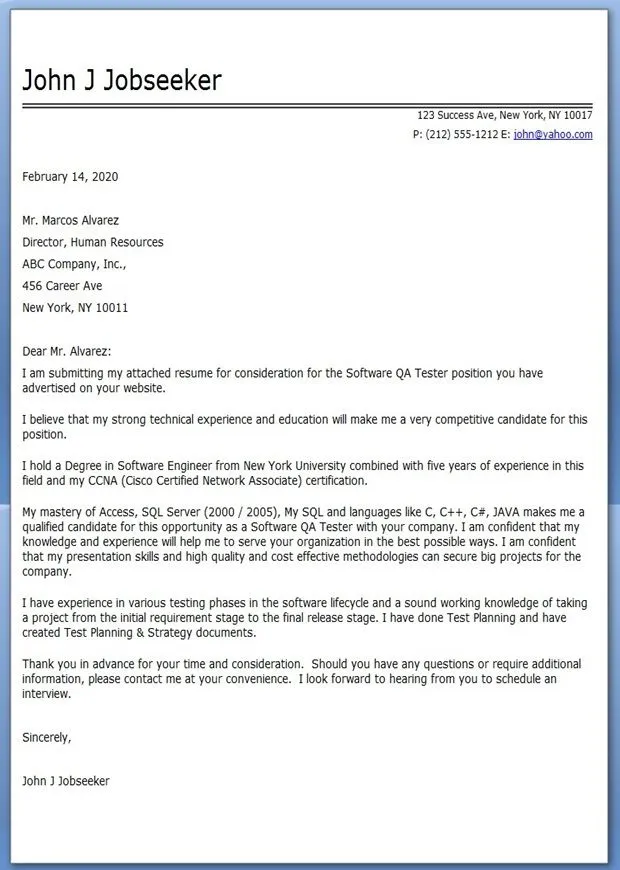Understanding the Importance of a QA Cover Letter
In the competitive world of Quality Assurance, a well-crafted cover letter is your first chance to make a lasting impression on potential employers. More than just a formality, it’s a crucial tool that can significantly boost your chances of landing an interview. It provides a platform to showcase your personality, skills, and enthusiasm, going beyond what a resume alone can convey. A compelling cover letter can set you apart from other applicants, demonstrating your genuine interest in the role and the company, making it an indispensable part of your job application process. The primary goal is to quickly grab the attention of the hiring manager and encourage them to delve deeper into your application.
Why a QA Cover Letter Matters
A QA cover letter matters because it serves as a personalized introduction to your application. It’s your opportunity to explain why you’re the perfect fit for the specific role and company. It allows you to tailor your qualifications to the job description, highlighting the skills and experiences most relevant to the employer’s needs. A cover letter complements your resume by providing context and narrative, illustrating how your past experiences align with the job’s requirements. It is also a way to demonstrate your writing and communication skills, which are essential in QA roles. It offers insights into your problem-solving abilities, attention to detail, and your passion for quality, all of which are critical in the field.
Impact of a Strong Cover Letter
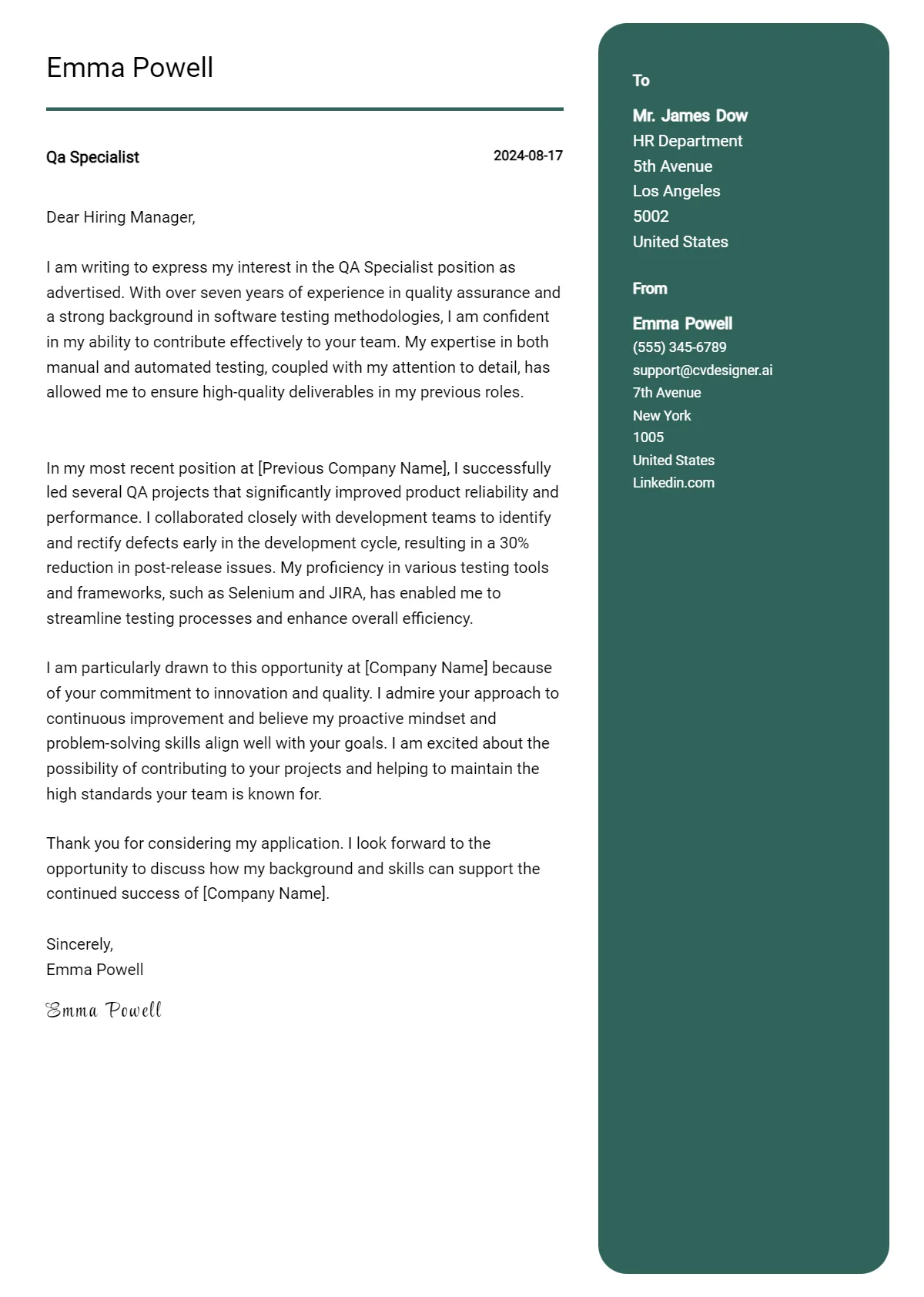
A strong cover letter can significantly increase your chances of securing an interview. It makes your application more memorable and gives you a competitive edge. By clearly articulating your value proposition, you demonstrate that you’ve taken the time to understand the role and the company’s needs. A well-written cover letter can showcase your technical abilities, your soft skills, and your achievements in a way that the resume alone cannot. It can also help to overcome any gaps in your work history or address any concerns the hiring manager might have. Ultimately, a compelling cover letter influences the recruiter, making them want to learn more about you and invite you for an interview. Remember, first impressions are critical.
Key Components of a Successful QA Cover Letter
A successful QA cover letter combines a professional tone with a clear and concise message. It’s essential to include specific elements that showcase your skills, experience, and enthusiasm for the role. These components, when combined effectively, increase the likelihood of capturing the hiring manager’s attention. The key is to strike a balance between providing detailed information and keeping the letter focused and easy to read. Your goal should be to demonstrate you are a highly qualified candidate and express your genuine interest in the opportunity. Therefore, you must include these key components to increase your success rate.
Contact Information & Salutation
Start with your contact information (name, phone number, email, and optionally your LinkedIn profile URL) at the top of the letter. Always address the hiring manager by name if possible; otherwise, use a professional greeting like ‘Dear Hiring Manager’. This personalized touch immediately grabs the reader’s attention. It shows that you’ve done your research and are genuinely interested in the role. It sets a professional tone from the outset and demonstrates your attention to detail, a crucial skill in QA. Correctly addressing the recipient adds a personal touch, making the letter more engaging and memorable.
Highlighting Your QA Skills
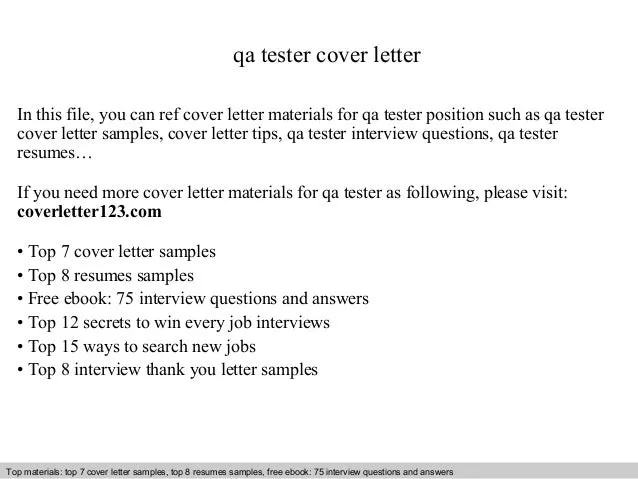
The body of your cover letter is where you highlight your relevant QA skills. This section should focus on what makes you a strong candidate for the role. It should be concise, specific, and tailored to the job description. This involves carefully reviewing the job requirements and addressing each one with relevant examples. The goal is to show how your experience aligns with their needs. Use clear language, and avoid jargon unless you’re sure the hiring manager will understand it. This section is crucial, so take the time to craft it thoughtfully, ensuring it resonates with the requirements.
Technical Skills
List and describe your technical skills, such as experience with testing tools (e.g., Selenium, JUnit, TestRail), programming languages (e.g., Java, Python), and testing methodologies (e.g., Agile, Waterfall). Provide specific examples of how you’ve used these skills in previous roles. For example, mention the specific testing tools you are comfortable with and detail the testing types you are proficient in. If you have certifications, be sure to include those too. Quantify your achievements whenever possible; for example, specify how you improved test coverage or reduced the number of bugs. This demonstrates a solid understanding of the technical requirements and showcases your competence.
Soft Skills
Highlight your soft skills, such as communication, problem-solving, attention to detail, teamwork, and time management. Provide examples of how you’ve used these skills to achieve positive outcomes. For instance, describe how you effectively communicated complex technical issues to non-technical stakeholders. Showcase your ability to work collaboratively in a team environment and describe how you resolved conflicts or contributed to a positive work environment. Show your problem-solving skills by explaining how you’ve tackled challenging bugs or testing scenarios. Provide any example that demonstrates your capability to apply these soft skills effectively.
Showcasing Your Achievements
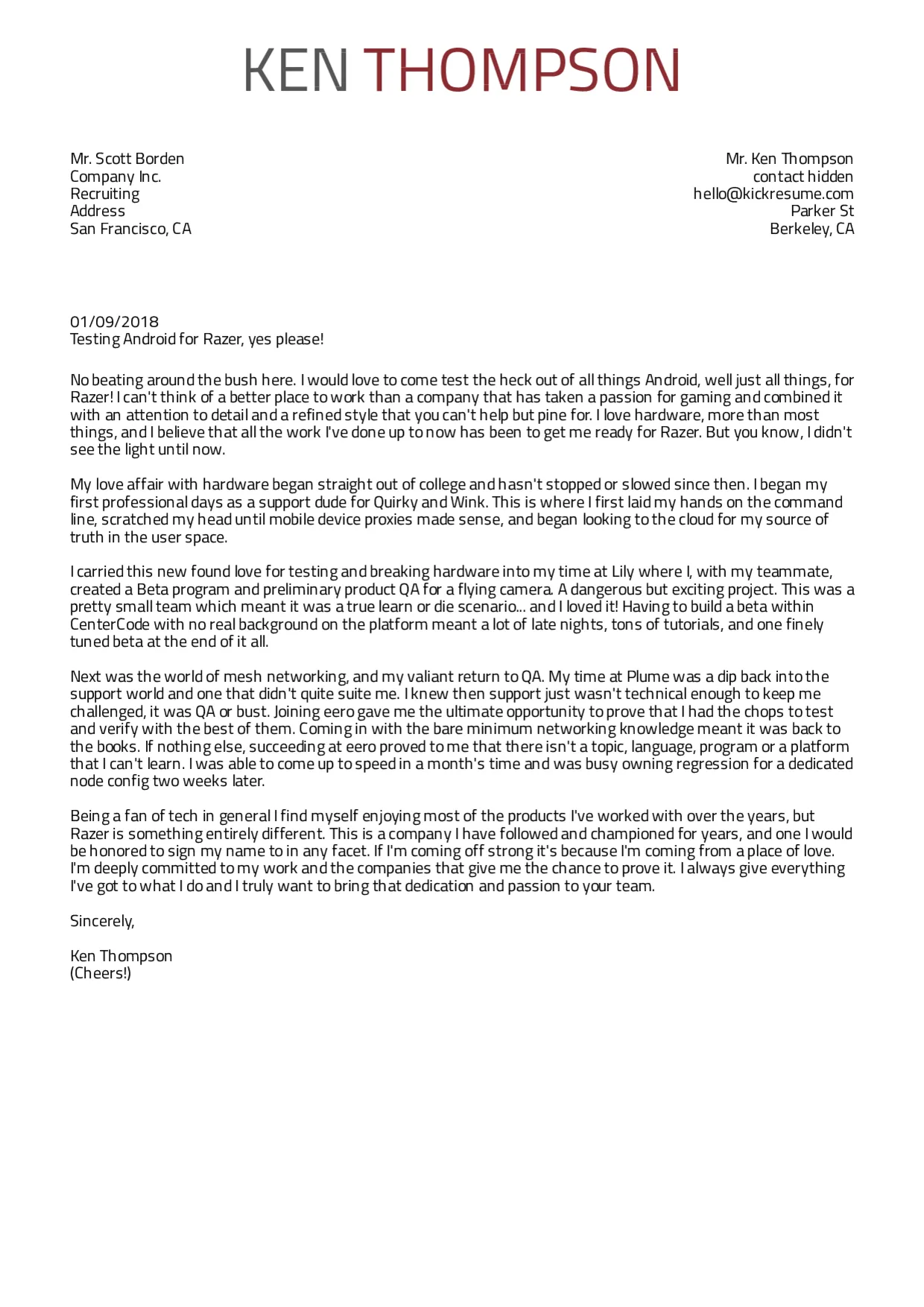
Instead of simply listing your responsibilities, highlight your achievements and quantify them whenever possible. This will demonstrate the impact you’ve had in previous roles. Focus on results-oriented statements that showcase how you added value. This section should provide tangible evidence of your capabilities and successes. For instance, how did you improve test efficiency, reduce bugs, or contribute to faster release cycles? Each accomplishment must be followed by a detailed example. Highlighting your achievements makes your cover letter compelling and shows you are a results-oriented individual.
Quantifiable Results
Use numbers and metrics to quantify your achievements. For example, instead of saying ‘Improved testing efficiency,’ say ‘Increased test automation coverage by 30%, reducing test execution time by 20%.’ Provide specific data points to support your claims. Using metrics will show your success in your previous positions, and also demonstrate your ability to measure and evaluate results. Quantifiable results make your accomplishments more credible and demonstrate your capability to contribute to the company’s goals. Use figures whenever possible.
Specific Project Examples
Provide specific examples of projects where you successfully applied your QA skills. Describe the project, your role, and the outcomes you achieved. This helps the hiring manager understand your practical experience. Focus on projects relevant to the role you are applying for. Clearly state the project’s objectives, your responsibilities, and the results of your efforts. Use this section to highlight the tools, methodologies, and strategies you used. Give a brief overview of the project’s goals and show your contributions and the impact you had on those projects.
Tailoring Your Cover Letter
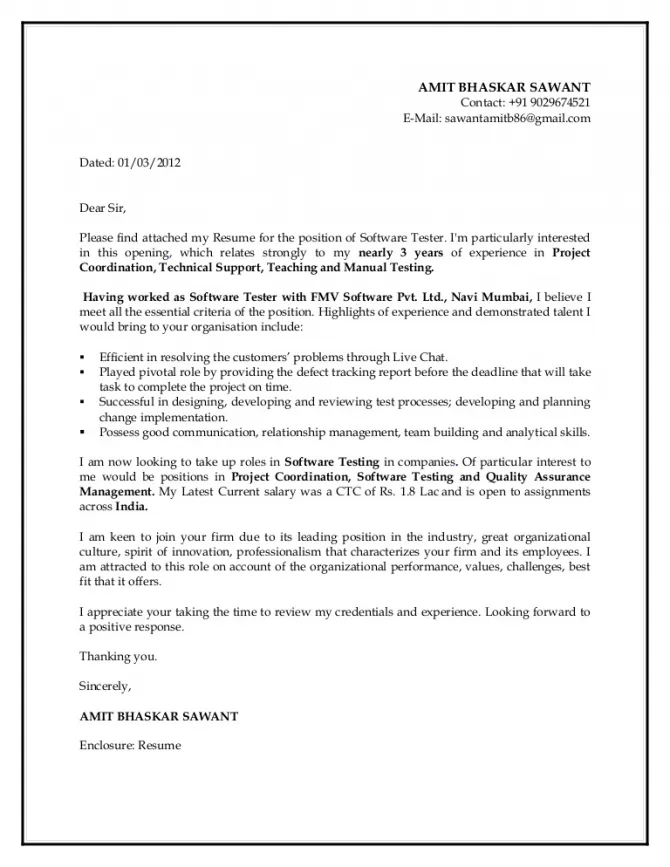
Tailoring your cover letter is essential to increase your chances of getting noticed by the employer. This involves personalizing your letter to match the specific requirements of the job description and the company’s culture. This level of detail demonstrates your genuine interest in the position and that you are willing to take extra effort to research and understand the company’s values and requirements. Tailoring your cover letter should not be overlooked, as it allows you to create a great first impression on the hiring manager.
Researching the Company
Before writing your cover letter, research the company thoroughly. Understand their mission, values, products, and recent projects. This will help you tailor your letter to demonstrate that you understand their needs and are a good fit. Visit their website, read their press releases, and check their social media presence. Identify what makes the company unique, and incorporate these details in your cover letter. Mentioning specific projects or company values shows that you care about the company’s goals and are interested in contributing to their success.
Matching Skills to Job Description
Carefully review the job description and identify the key skills and qualifications the employer is seeking. Then, align your skills and experience to these requirements. Use the same keywords and phrases from the job description to ensure your qualifications are easily recognized by the hiring manager. Highlight how your past experiences have prepared you for the specific role and responsibilities. Show how your skills match the requirements listed in the job posting, emphasizing why you are a good fit for their needs.
Customizing for Each Application
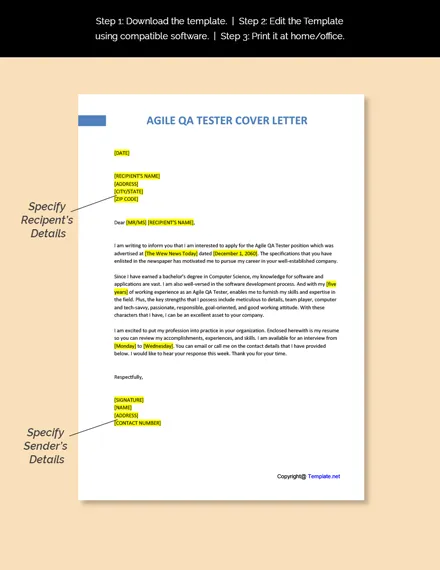
Avoid sending generic cover letters. Each cover letter should be customized to the specific job and company. Tailor the content to address the company’s needs, the role’s requirements, and the company’s culture. Personalize your letter by mentioning the company, the specific role, and the reasons you are interested in this opportunity. This shows the hiring manager you have invested the time to understand their specific requirements. Customizing your application significantly increases your chances of standing out from other candidates.
Formatting and Presentation Tips
The formatting and presentation of your cover letter can significantly affect its impact on the reader. It’s important to make your cover letter easy to read, visually appealing, and professional. This is achieved through proper formatting and presentation. Pay attention to details such as font choices, spacing, length, and overall structure. Properly formatted cover letters show your attention to detail, and that you care about your overall image. Proper formatting is critical to showcasing your professionalism.
Font and Readability
Choose a professional and easy-to-read font, such as Arial, Calibri, or Times New Roman, with a font size between 11 and 12 points. Ensure there’s sufficient spacing between lines and paragraphs to improve readability. Use clear headings and subheadings to organize the content. Avoid using overly fancy fonts or complex layouts that can distract the reader. A clean and well-organized format makes your cover letter visually appealing and easy to read, allowing the hiring manager to quickly understand your qualifications and experience.
Length and Structure
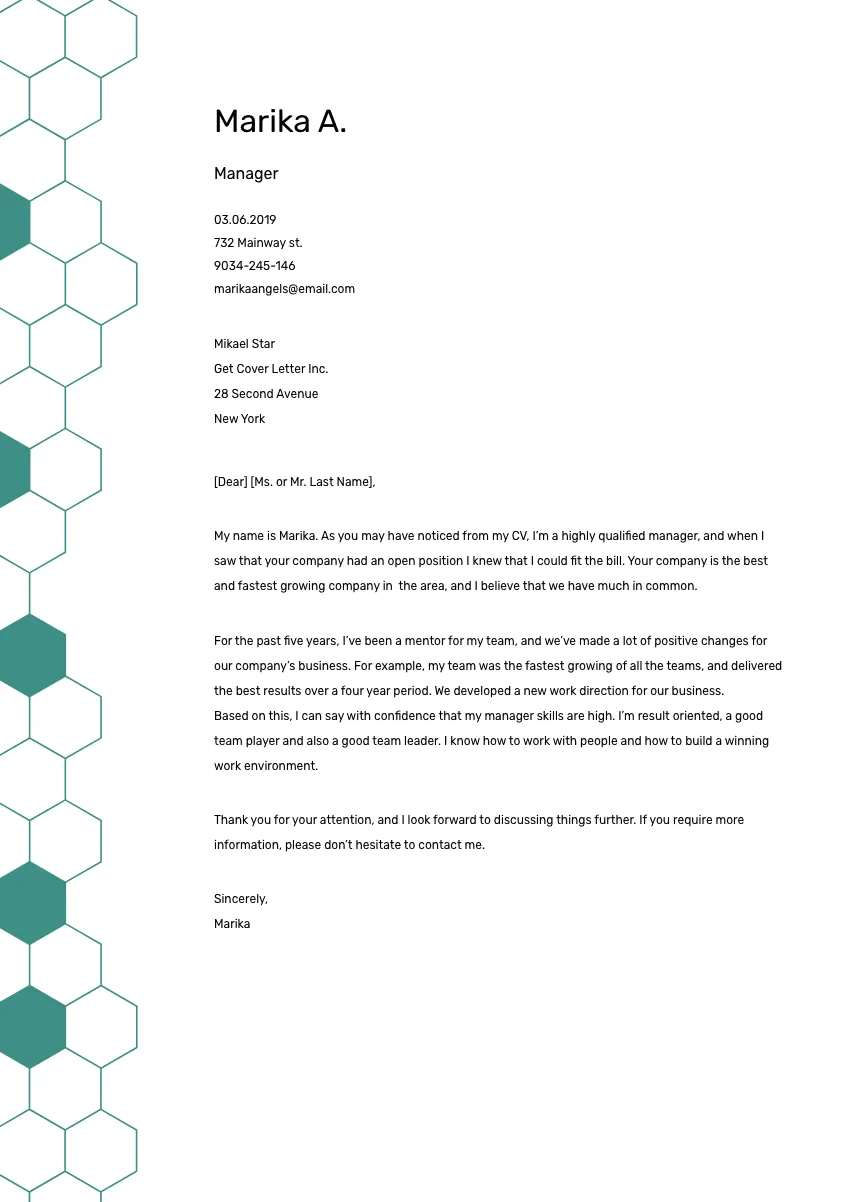
Keep your cover letter concise, ideally no more than one page. Use a clear and logical structure with an introduction, body paragraphs highlighting your skills and experience, and a conclusion summarizing your interest and call to action. The introduction should grab the reader’s attention, the body should provide detailed information, and the conclusion should reiterate your enthusiasm and call for an interview. A well-structured cover letter ensures that your key points are clearly communicated and the hiring manager can easily follow your narrative.
Proofreading and Editing
Proofread your cover letter carefully for any grammatical errors, typos, or spelling mistakes. Have someone else review your letter for a second opinion. Errors can undermine your credibility and leave a negative impression. Take your time, and proofread your cover letter multiple times, and use spell-check tools. Double-check the details to ensure there are no factual errors. A polished and error-free cover letter demonstrates your attention to detail and professionalism, reflecting your dedication to quality.
Common Mistakes to Avoid
Avoid common mistakes that can ruin your chances of getting hired. Addressing these mistakes helps you create a strong and effective cover letter. Recognizing and avoiding these pitfalls shows you’re prepared and ready to make a positive impression. The aim is to make your application standout in the best way possible.
Generic Content
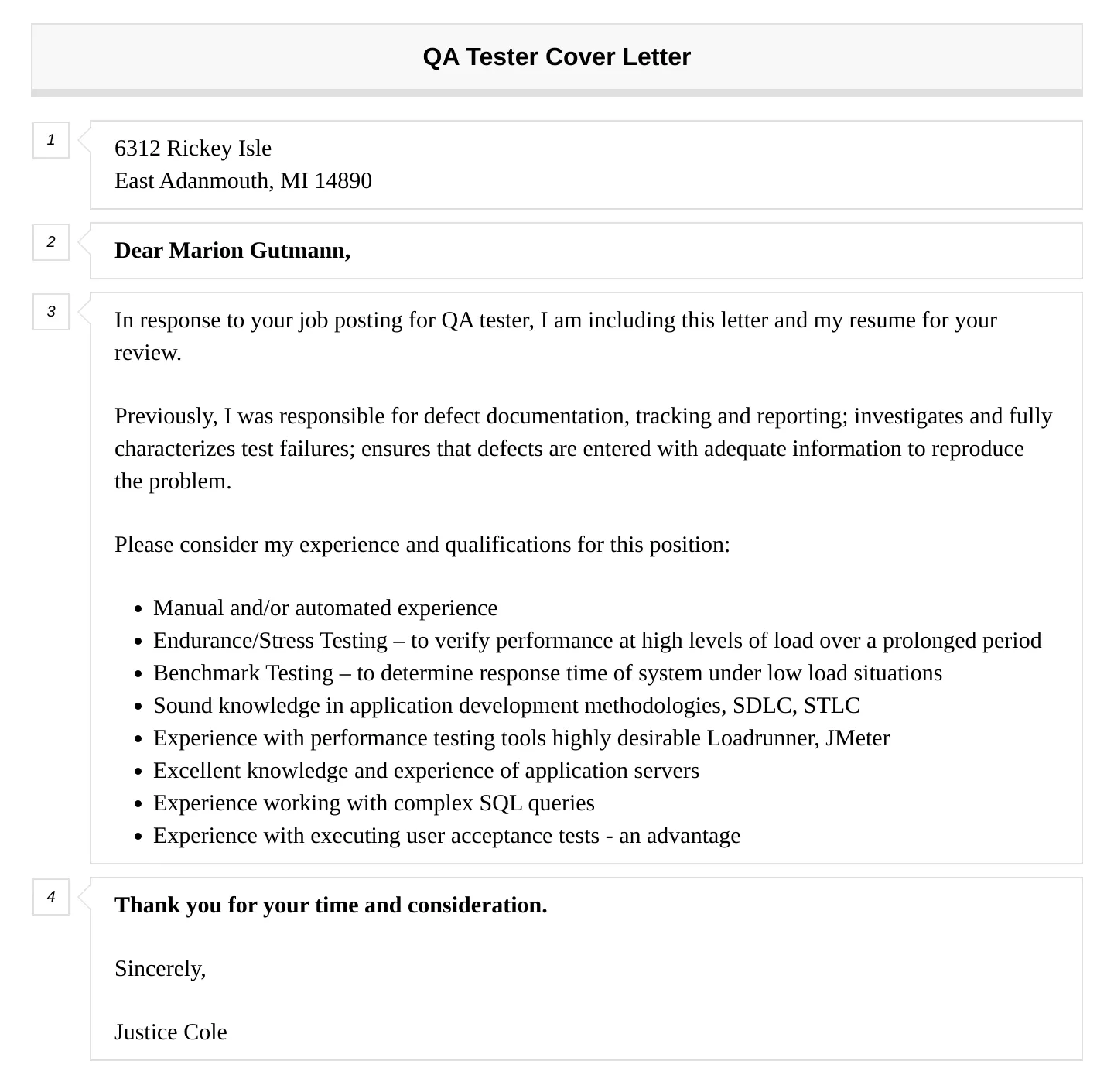
Avoid using generic or template-like content. Such content shows you have not customized your cover letter for the specific job. Your cover letter should clearly reflect that you’ve researched the company and are genuinely interested in the role. Use the company’s name, and address the specific requirements of the role, and highlight your alignment with their values. Generic cover letters show a lack of effort and may be ignored by hiring managers. Make the application personalized to maximize your chances of being noticed.
Typos and Grammatical Errors
Typos and grammatical errors can damage your credibility and professionalism. Always proofread your cover letter carefully and use grammar and spell-checking tools. A cover letter filled with errors suggests a lack of attention to detail, which is crucial in QA. Review your cover letter multiple times and consider asking a friend or colleague to review it. A well-written and error-free cover letter demonstrates that you care about quality, which is essential.
Failing to Highlight Relevant Skills
Make sure your cover letter highlights the skills and experiences that are most relevant to the job description. Review the job requirements and emphasize how your qualifications align with those needs. Your cover letter should showcase your technical skills, soft skills, and achievements in a clear and compelling way. Failing to mention your relevant skills may cause the hiring manager to overlook your application. Align your skills with their requirements to make sure that you show a perfect match.
Examples of Effective QA Cover Letters
Reviewing examples of effective QA cover letters provides insight into how to present your skills and experience. These samples can serve as inspiration for your cover letter. By looking at examples, you can see how to tailor your letter, highlight your accomplishments, and address the company’s needs. These examples can guide you in writing a compelling cover letter that catches the recruiter’s attention. These examples will provide you with several different ways to frame your cover letter.
Example 1 Focus on Technical Proficiency
This type of cover letter highlights your technical abilities and experience with specific testing tools and methodologies. It emphasizes your technical strengths and provides examples of how you’ve used your skills to solve problems or improve test efficiency. In this example, you can provide examples of the tools you are skilled in. It shows your deep understanding of QA processes. This should be a great example if you are applying for a technical role.
Example 2 Emphasizing Teamwork and Communication
This type of cover letter highlights your ability to work collaboratively and communicate effectively. It focuses on examples of your soft skills, such as teamwork, communication, and problem-solving. You can show your ability to work effectively with stakeholders. This shows you are a collaborative candidate, showing your ability to work with others, and clearly communicate complex information. Show examples of these skills to support your claim.
Example 3 Demonstrating Problem-Solving Abilities
This example highlights your ability to approach complex issues. It shows your problem-solving and analytical skills. In this letter, describe how you have resolved testing challenges, identified bugs, and ensured software quality. This example should showcase how you approach complex problems. This shows you are a resourceful and results-oriented candidate.
Finalizing Your QA Cover Letter
As you finalize your QA cover letter, remember to end with a strong call to action and express your enthusiasm for the opportunity. These final touches leave a lasting impression on the hiring manager. It is crucial to end with a clear call to action, and a message that shows you are genuinely interested in the position. The last impression is often the most memorable. Therefore, it is important to end with a clear message.
Call to Action
Conclude your cover letter with a clear call to action, such as ‘I am eager to discuss my qualifications further’ or ‘I look forward to the opportunity to speak with you about this role.’ This prompts the hiring manager to take the next step. A direct call to action guides the hiring manager to the next step. A clear call to action is essential. It also shows that you are proactive, and interested in the role.
Expressing Enthusiasm
End your cover letter by expressing your enthusiasm for the role and the company. Mention why you are interested in the opportunity and what you admire about the company. This personal touch shows that you are genuinely motivated and eager to contribute to their success. It shows the hiring manager that you’re passionate and interested. Expressing your enthusiasm will leave a memorable impression. This will improve your overall chances of getting hired.
